When this production of Puccini’s Madama Butterfly premiered in
2003, I remember being startled at how stark the production seemed, with its
clean horizontal lines and open spaces. Very different indeed from the
over-stuffed, over-fussy clutter of fin de siËcle clichÈs about
Japan. WesternJaponisme as decorative wrapping has little to do with
reality. Madama Butterfly is a powerful opera because it deals with
real human dilemmas, by no means unique to Japan or to the early 20th
century.
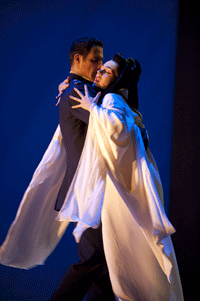 James Valenti as Pinkerton and Krist?ne Opolais as Cio-Cio-San
James Valenti as Pinkerton and Krist?ne Opolais as Cio-Cio-San
Instead, this production, directed by Moshe Leiser and Patrice Caurier, uses
the Japanese context intelligently so it works with the drama. Japanese art is
stylized, blank spaces part of the design, so key details stand out in sharp
focus. The sets in this production, designed by Christian Fenouillat, are clean
and open, so there’s no irrelevant distraction. The backdrop of shoji screens
allows quick scene changes, contrasting the interior with the vast panorama
outside. It’s a telling comment. As Goro points out, changing the walls
changes perspective. This opera isn’t really “about” Japanese society as
much as about the way people don’t perceive things in the same way.
As Caurier and Leiser said in their recent
interview with Opera Today, Madama Butterfly is “not a beautiful
story, it’s awful, it’s violent. Yes, you see the flowers but you must have
the smell of blood running through them”. Throughout history, those with
wealth and power have always been able to exploit those who don’t. Pinkerton
buys a package, house, servants, mock family and a girl to use as sexual
convenience. He’s infatuated temporarily by Butterfly’s beauty but he’s
under no illusion that he’s interested in her other than as an object to
gratify his ego. Perhaps that’s why he takes the child. He can’t conceive
that its mother or culture mean anything.
Butterfly is so desperate to escape her background that even before she
meets Pinkerton, she’s obsessed about becoming an instant American. She
invests so much in her delusion that she can’t cope with reality. She kills
herself, not simply because harakiri “is” custom, but because
she’s invested so much into her fixation that she can’t live with
reality…“nulla, nulla, fuor che la morte”.
Although this is the third revival of this production since 2003, the
performance felt vivid because it was directed, not by substitutes, but by
Leiser and Caurier themselves. Every performance has to be “new” because
casts change and circumstances change. Patricia Racette, who has sung Cio Cio
San many times before, pulled out at the last minute, but in some ways that was
fortunate, because Kristine Opolais, making her Royal Opera House debut, throws
herself so convincingly into the part that she makes it her own. She’s young
enough to convey Butterfly’s innocence but has strength of personality, which
comes through in her singing. She sings the love duet with such intensity that
you wonder how a 15 year old could find such passion, especially for a stranger
she’s just met. This emphasizes Butterfly’s single-minded determination.
Reality doesn’t get in the way of imagination.
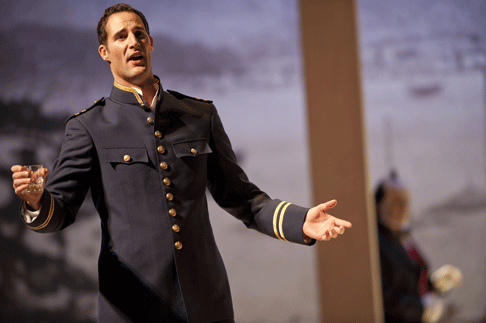 James Valenti as Pinkerton
James Valenti as Pinkerton
Opolais’s Butterfly is nicely varied. After the Bonze’s curse, her voice
takes on a tense edge, showing that Butterfly is deeply traumatized, but soon
switches back to gentleness when she turns to Pinkerton. Swift reactions
matter, for Cio Cio San is always adapting, and living intensely in the moment.
Opolias’s interaction with Dolore (Niklas Allan) feels genuine. She’s not
singing to an object, or a puppet, but as real mother to real child. Madama
Butterflies stand and fall on “Un bel di vedremo”, and Opolais conveys true
emotional engagement. She’s not merely describing a sequence of events, but
how they feel to her. An interesting voice, with good range, and a natural
acting singer. She’s a regular at the Berlin Staatsoper, where she’ll be
singing Butterfly in March 2012.
James Valenti as Lt. Pinkerton is rather less successful, although he has
had the role in his repertoire for years. Arguably, Pinkerton is emotionally
more buttoned up than many men, but Puccini builds a lot more into the part
than repression. Perhaps further into the run, Valenti’s voice may blossom,
and hopefully be preserved at its best in the film that’s being released on
BP Big Screen and cinemas on 4th July. Anthony Michaels-Moore sang Sharpless
with warmth, for the Consul is a figure of reasonableness in this
claustrophobic world of extremes.
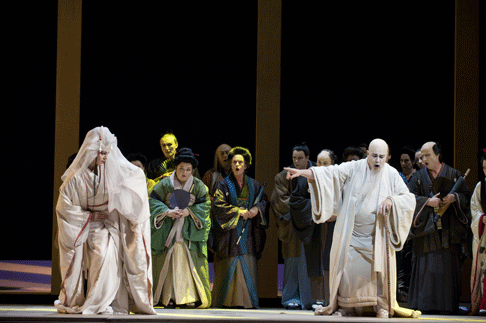 Krist?ne Opolais as Cio-Cio-San and Jeremy White as Bonze
Krist?ne Opolais as Cio-Cio-San and Jeremy White as Bonze
From the vigour with which Robin Leggate sang Goro, it was hard to believe
that he’s retiring after the end of this production, his 909th performance at
the Royal Opera House, since 1977. This Goro is directed so he moves swiftly,
reflecting the character’s quick wits and cunning. Leggate sings with
unflagging energy, despite having to be fleet of foot.
Similarly, Helene Schneiderman’s Suzuki was vibrant and expressive.
There’s a lot more to this role than mere servant. Suzuki can be cocky,
although she’s loyal. Cio Cio San isn’t completely the mistress even at
home. Schneiderman intones her prayer to the gods so forcefully that when she
sings with Butterfly, you pick up on the undercurrent of tension that exists
even in their relationship. Suzuki’s gods will win; Cio Cio San hasn’t a
chance.
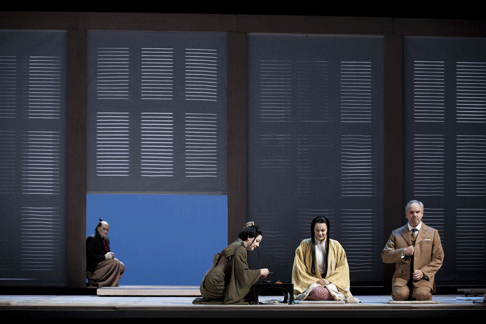 Robin Leggate as Goro, Helene Schneiderman as Suzuki, Krist?ne Opolais as Cio-Cio-San and Anthony Michaels-Moore as Sharpless
Robin Leggate as Goro, Helene Schneiderman as Suzuki, Krist?ne Opolais as Cio-Cio-San and Anthony Michaels-Moore as Sharpless
Buddhists don’t normally curse people, and in Japan, Buddhism co-exists
with Shinto quite happily. Buddhists have a lot in common with Christians too.
This Bonze is a figment of Puccini’s imagination, created to inject extreme
panic, for he smashes forever Cio Cio San’s links with her past. Perhaps
that’s why in this production, he appears all-white, like an apparition of a
ghost from a Japanese horror story, not as a living monk. Jeremy
White’s Bonze bursts onto the scene, screaming violently, striking
terror. Great theatre, as Puccini must have intended.
Zhengzhong Zhou sings Prince Yamadori and Daniel Grice sings the Imperial
Commissioner. Both impressed, proving how the Jette Parker Young Artists
Programme nurtures singers in good directions. Yamadori is an interesting role
which could be developed more than it usually is. Why would a prince marry a
second-hand geisha, especially one who’s been cursed for consorting with
foreigners? He rides a carriage up the steep hill, whereas everyone else in
this opera walks. Why would a man of that status humiliate himself by divesting
all his other wives? Zhou sings the part with tenderness, creating a sincere
Yamadori who is emotionally honest and vulnerable though he has all the
trappings of power. Pinkerton in reverse?
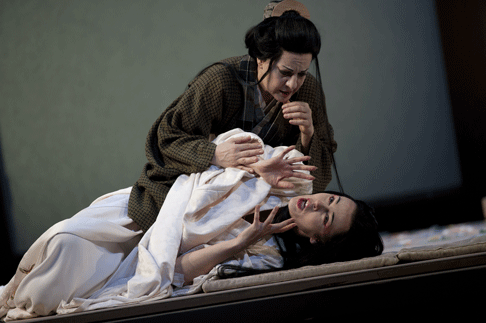 (Front to Back) Krist?ne Opolais as Cio-Cio-San and Helene Schneiderman as Suzuki
(Front to Back) Krist?ne Opolais as Cio-Cio-San and Helene Schneiderman as Suzuki
Andris Nelson conducted. He’s currently Music Director at the City of
Birmingham Symphony Orchestra (Simon Rattle’s former post), but conducts a
lot of opera, including engagements in Bayreuth, New York, Berlin and
Vienna.
For more information, please see the Royal Opera House
website.
Anne Ozorio
image=http://www.operatoday.com/MADAMA-BUTTERFLY.10077_0190.gif
image_description=Krist?ne Opolais as Cio-Cio-San [Photo by Mike Hoban courtesy of The Royal Opera]
product=yes
product_title=Giacomo Puccini: Madama Butterfly
product_by=B F Pinkerton: James Valenti; Goro: Robin Leggate; Suzuki: Helene Schneiderman; Sharpless: Anthony Michaels-Moore; Cio Cio San: Kristine Opolais; Imperial Commissioner: Daniel Grice; Cio Cio San’s family: Eileen Hamilton; Alan Duffield; Elizabeth Key; Kiera Lyness; The Bonze: Jeremy White; Prince Yamadori: Zhengzhong Zhou; Dolore: Niklas Allan; Kate Pinkerton: Rachael Lloyd. Orchestra and Chorus of the Royal Opera House. Conductor: Andris Nelsons. Directors: Moshe Leiser and Patrice Caurier. Set Designer: Christian Fenouillat. Costume Designer: Agostino Cavalca. Lighting Designer: Christopher Forey. Royal Opera House, London, 25th June 2011.
product_id=Above: Krist?ne Opolais as Cio-Cio-San
All photos by Mike Hoban courtesy of The Royal Opera